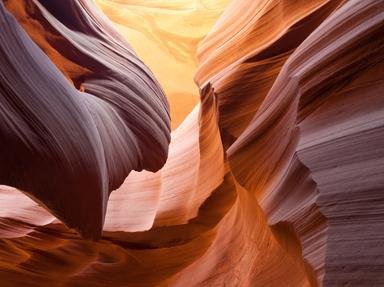Quiz Answer Key and Fun Facts
1. Phosgenite is a peachy coloured transparent mineral that is primarily found on the island of Sardinia. It was so named as the discoverers believed they could extract phosgene from it, but this is not true. It does, however, contain a different toxic substance. What is this substance?
2. Anglesite is a different mineral from phosgenite, although they are very similar in their chemical make-up. While phosgenite is peach coloured, anglesite is any colour from transparent to green. Today, it is found in many places, including Brazil and Morocco, but where was it originally found?
3. Some minerals are fluorescent when put under an ultra-violet light. This means that they show a different colour when placed under a UV beam. Which of these minerals is not fluorescent?
4. Gaudefroyite is a black, striated mineral which forms masses of small crystals. Because of the chemical make up of Gaudefroyite, it often occurs with another type of mineral. What?
5. Cavansite is one of the few minerals that only ever occurs in one colour. What colour is it?
6. Which of the following minerals is most chemically similar to the dark pink mineral, eosphorite?
7. Ludwigite is a mineral which forms orthorhombic crystals, and it is often found on a bed of Albite. Chemically similar to Gaudefroyite, this mineral is dark green to black in colour, but what is the hardness of this mineral on the Mohs scale?
8. Natrolite, Harmotome, Chabazite, Stilbite, and Heulandite are all examples of which type of mineral?
9. Which of these is the correct description of the mineral Girosol?
10. In which of these locations might you find Villiaumite, a dark red crystal of the halide family which forms isometric crystals?
11. Kornerupine is a dark-green, crystal forming mineral which is part of the Harkerite series of minerals. It is a hard mineral, at seven on the Mohs scale, and is related to minerals such as Grandidierite and Dumortierite. What family does this mineral belong to?
12. Gmelinite is a mineral which forms three distinct different chemical forms. These are Gmelinite Ca, Gmelinite Na, and Gmelinite K. Who was this mineral named for, though?
13. Kämmererite is an unusual mineral, and very rare. It forms both granular and crystalline habits, and is primarily found in Turkey and Russia. What colour are the spectacular crystals of Kämmererite?
14. Indicolite is widely accepted as the dark blue variety of which other form of Tourmaline?
15. Which of these minerals forms crystals that are clear, occasionally with a blue or green tint?
Source: Author
Flynn_17
This quiz was reviewed by FunTrivia editor
crisw before going online.
Any errors found in FunTrivia content are routinely corrected through our feedback system.

